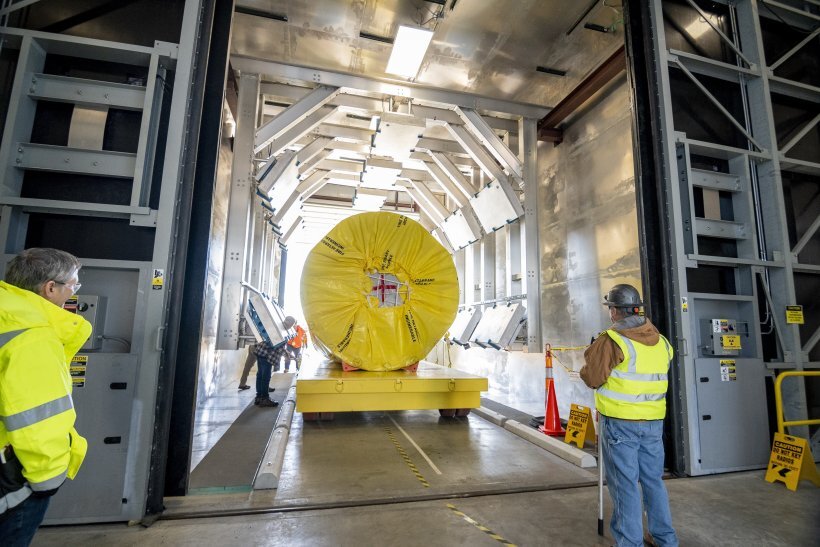
Revolutionizing Nuclear Waste Management with LINAS Scanning Facility

Image courtesy of the U.S. Department of Energy – originally published on energy.gov
Mirion Celebrates its Contributions to the DOE’s Groundbreaking Project to Enhance Safety and Efficiency in Decontamination and Decommissioning Efforts
Mirion Technologies has played a pivotal role in the development and implementation of the Large Item Neutron Assay System (LINAS) at the Paducah Gaseous Diffusion Plant in Kentucky. This state-of-the-art facility, commissioned by the Department of Energy (DOE), marks a significant milestone in the field of nuclear waste management and sets a new standard for safe and efficient decontamination and decommissioning processes.
About the Paducah Site
The Paducah Gaseous Diffusion Plant (PGDP), established in 1952, has played a pivotal role in the United States’ nuclear history, initially producing enriched uranium for the nation’s nuclear weapons program and subsequently for commercial nuclear power plants. Since the late 1980s, the DOE has been actively involved in extensive cleanup activities at the site. These activities encompass a broad range of tasks including environmental remediation, waste management, depleted uranium conversion, and decontamination and decommissioning. This ongoing effort is crucial for mitigating environmental risks and ensuring the safe repurposing of the site.
First-of-its-Kind Scanning Facility
Completed in July-August 2023 and operational as of January 2024, the LINAS scanning facility is designed to accurately measure and assess the radioactive material content in large-scale metallic plant equipment. This groundbreaking system enables precise measurements, ensuring safe disposal and enhancing worker safety. By utilizing Mirion’s custom-designed neutron counting system and manufacturing expertise, LINAS revolutionizes the way equipment and waste are scanned, packaged, and disposed of at the Paducah site.
One of the key benefits of the LINAS system is its ability to count large items without size limitations, significantly reducing the physical labor required for size reduction. This not only enhances worker safety but also improves cost savings, efficiency, and speed in the decontamination and decommissioning process. Mirion’s contributions to the LINAS project have been instrumental in achieving these remarkable advancements.

Technicians position a process gas converter bundle in the Large Item Neutron Assay System for measurement. Image courtesy of the U.S. Department of Energy. Originally published on energy.gov
Mirion Custom Neutron Counting System
The LINAS scanning facility incorporates advanced neutron detection technology, allowing for precise measurements of material holdup within the plant equipment. The system can accommodate objects up to 13.5 feet in diameter and 24 feet in length. With a minimal detectable activity (MDA) of 25 grams or less for any given object and a total measurement uncertainty (TMU) of less than 35%, LINAS ensures accurate and reliable results.
Aimed at advancing efficiency of scanning plant equipment, the system boasts a throughput capability of 10 or more objects per day, with a target measurement time of 30 minutes each.
For full details, read the paper presented by Mirion at the 2024 Waste Management conference here.

In designing the LINAS Neutron Detector, Mirion reused 124 He-3 tubes from a previously decommissioned system for a significant reduction in cost.
Mirion’s expertise in neutron detection and measurement played a crucial role in overcoming technical challenges associated with the LINAS project. The presence of cosmic-ray spallation (CRS) neutrons and the enormous amount of metal in the plant equipment posed significant obstacles. However, through extensive modeling and optimization efforts, Mirion successfully minimized background neutron count rates and achieved uniform detection efficiency over the object volume.
According to an article published on the Office of Environmental Management website announcing the system’s successful startup:
“During startup of LINAS, the scanning technology produced test data demonstrating it is the most accurate measuring system in the world for the large equipment removed from the C-333 Process Building. Aside from the accuracy of the scanning technology, measurements of deposits can be completed in a fraction of the time compared to other large component measurement methods, resulting in greater efficiency.”
Read the full article here.
The LINAS scanning facility at the Paducah Site is a testament to the collaborative efforts between Mirion Technologies, the DOE, and other project partners. The successful implementation of this groundbreaking project sets a new standard for nuclear waste management and paves the way for safer and more efficient decontamination and decommissioning processes in the future.
Learn more about Mirion’s capabilities for Waste Management.


